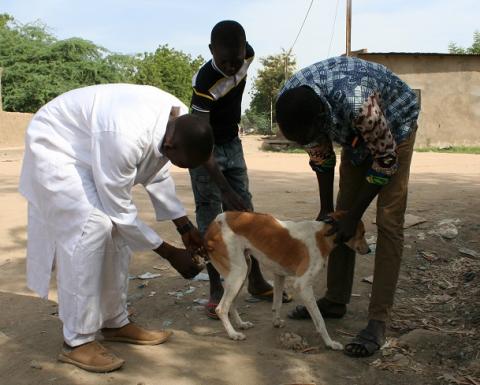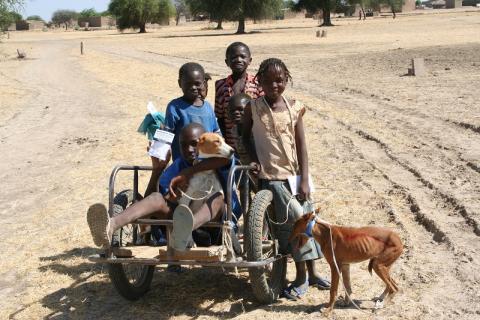Modelling helps to better understand rabies transmission
- Community News
- Dog vaccination
Citywide vaccination campaigns in N’Djamena, the capital city of Chad, and a deterministic model based on epidemiological data have demonstrated that rabies elimination can be achieved in Africa. The modelling research was published in December in Science Translational Medicine.
Dog vaccination was undertaken from October to December 2012 and during the same months in 2013. In both intervention rounds around 20,000 dogs were vaccinated, which represents about 70% of N’Djamena’s dog population. Before the campaign, dog rabies was prevalent in N’Djamena with around 4 cases observed per month, which represents an annual incidence of 0.7/1000 dogs. After the campaigns, no dog rabies cases were observed in the city for over 9 months (January to October 2014).
The transmission model suggests that the conditions for rabies virus persistence in N’Djamena’s dog population were not maintained and that interruption of dog to dog transmission occurred from early 2013 to November 2014. The model also showed that population replacement by the birth of susceptible dogs contributed more strongly to the loss of population immunity than individual dog immunity loss.
Analysis of viral phylogenetic data was also carried out and agreed with the transmission model, that the viral reproductive number, which is the average number of new infections resulting from a rabid dog, fell below 1.
Recurring rabies cases observed in the city from October 2014 onward are strongly suspicious of reintroduction, rather than sustained ongoing transmission from 2013. Dog rabies cases from 2014 onward were phylogenetically distinct from those circulating in N’Djamena before the intervention and were most likely imported from peri-urban and rural areas adjacent to the vaccination zone.
The findings highlight that dog rabies control in African cities should be planned for larger areas, including suburban and rural areas, and be coordinated regionally between neighboring countries to achieve sustainable elimination. The recent creation of the Pan African Rabies Control Network (PARACON) is, therefore, an important first step toward the goal of eliminating dog rabies from Africa by 2030.
N’Djamena has a very heterogeneous distribution of the dog population and very varied vaccination coverages were achieved by district. This demonstrates that dog vaccination campaigns will need to be adapted to local conditions to reach sufficient coverage. The study further supports the need for improvements in and reinforcement of rabies surveillance in rural and more remote areas to achieve inclusive and comprehensive rabies reporting that can then be used to guide vaccination decisions.
As other studies have previously shown, the example of N’Djamena shows that the amount of money invested per human lives saved is less for canine vaccination alongside post-exposure prophylaxis (PEP) than it is for PEP alone. The cost of the vaccination campaign amounted to around 5 USD per dog vaccinated. Based on the cost and performance of the intervention in N’Djamena and on a representative dog demographic survey conducted in 2014, the cost of a national Chadian dog vaccination campaign is estimate to be between 2.5 and 3 million Euros. Whether this investment will also lead to lower use of vaccine for PEP and consequently to cost savings for public health, depends strongly on a good collaboration between the human and animal health sector. However, dog vaccination is financially the best option for long term animal rabies control and rabies prevention in humans.
It can be concluded that mass vaccination of dogs, coupled with PEP, would be sufficient to eliminate rabies transmission in an African city, in both dogs and humans, as long as vaccination is extended to larger areas and coupled with dog movement control.
Contributed by Dr Monique Lechenne of the Swiss Tropical and Public Health Insitute (Swiss TPH). The vaccination campaigns and the research activities were a close collaboration between theSwiss TPH, their local partner NGO (Centre de Support en Santé International, CSSI) and the governmental veterinary laboratory (Institut de Recherche en Elevage pour le Developpement, IRED). Closely involved in the analysis of the rabies strains were also the Pasteur Institute in Paris and the Swiss Institute for Bioinformatics in Lausanne. Beside the modelling paper, other relevant articles can be found here, here and here.

